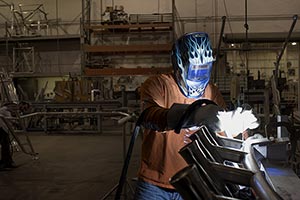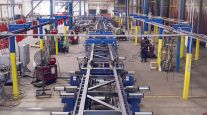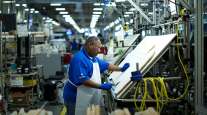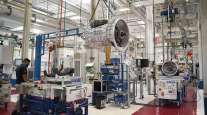Manufacturing Gains More Than Expected in June

Manufacturing in the United States last month posted the strongest advance since January, helped by automobile production and a sign domestic demand is improving.
The 0.4% gain at factories, which make up 75% of total industrial production, followed a 0.3% decline in May, a Federal Reserve report showed July 15 in Washington. The median forecast in a Bloomberg News survey of 25 economists called for a 0.3% rise. Total industrial production, which also includes mines and utilities, jumped 0.6%, also exceeding the median forecast and the biggest gain in almost a year.
Stabilization in oil and commodities prices and the fading drag from a stronger dollar are allowing manufacturers to find their footing. Trimmer inventories and a pickup in household demand will underpin factory activity, at the same time the fallout from the U.K.’s impending exit from the European Union poses a hurdle for American companies that sell overseas.
“As growth in consumer demand starts filtering through into the production front, we should see an improvement in manufacturing,” Jennifer Lee, a senior economist at BMO Capital Markets in Toronto, said before the report. “It’s still going to be a slow process.”
Manufacturing accounts for about 12% of the economy. Economists’ estimates in the Bloomberg survey ranged from unchanged to an advance of 0.6% for factory output. The previous month’s reading was revised from a drop of 0.4%.
For total industrial production, the Bloomberg survey of 77 economists showed estimates ranging from a decline of 0.1% to a rise of 0.9%. The prior month was previously reported as a decrease of 0.4%.
Capacity utilization, which measures the amount of a plant that is in use, rose to 75.4% from 74.9% in the prior month.
Utility output surged 2.4%, after a 0.9% drop the previous month, the Fed report showed.
The results probably reflected warmer weather. It was the warmest June on record for the 48 contiguous states, with above-average temperatures from coast to coast, according to the National Oceanic and Atmospheric Administration.
Mining production, which includes oil drilling, increased 0.2%, reflecting stabilization in the price of oil and other commodities.
The output of motor vehicles and parts increased 5.9% after a 4.3% drop a month earlier. Excluding autos and parts, manufacturing was unchanged after a 0.1% rise.
Machinery production increased 1.1%, and output of computers and electronics fell 0.5%. Construction materials dropped 0.8%. Consumer goods production jumped 1.1%, while output of business equipment climbed 0.7%.




